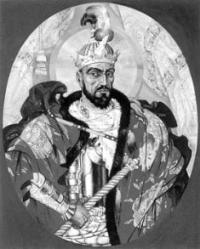You are here
Tombstones of Temur and his descendants.

Visit the Gur-Emir mausoleum Samarkand.
“People usually feel funny, smile and laugh when I tell them
about my strong belief in the very existence of prehistoric
advanced technology and great civilizations of wilier races.
I just can't wait to see their faces at time the truth is revealed”
Toba Beta.
Travel packages Uzbekistan.
Semenov A.A. drew attention to another problem posed by the mausoleum of Gur Emir. The jade tombstone of Amir Temur, his tombstone in the crypt, as well as the tombstone of Miranshah, located in it contain a very remarkable text from the pedigree of the Sokhibkaran family.
According to him, the family of Temur goes back to Amir Buzandzhiru, which is said here: “... And the father of this noble was not known, except that his mother (was) Alankuva. It is reported that she ... conceived him from the light [who] penetrated to her through the top door and appeared before her in the image of a perfect person.
He said that he was from the sons of the ruler of the faithful ‘Aliah, the son of Abu Talib; and it is repeatedly confirmed by its [Alankuva] claims on him [son ‘Alia] by her noble descendants, at all times victors over all.”
The fact that in this pedigree Temurids claim to be descended from the Bordzhiginids (descendants of Alankuv), considered among the Mongols as the sacred ruling family, is well in line with the traditional ideas about this family.
The most outstanding figure of the Bordzhiginids was Genghis Khan - the founder of the khan family. Amir Temur and his descendants, who were not Chingizids, to legitimize their power, used any opportunity to communicate with the descendants of Genghis Khan (fake khans, marriages with Chingizid princesses).
But there is another principle aspect in the pedigree text. Here, the Temurids associate themselves with Ali, claiming Seidic dignity, and specifically declaring their Shiite sympathies. By whose decree was this version of the Temurid pedigree stamped in stone?
Which of the descendants of Temur decided on such statements? It seems that at Sohibkaran such a viewpoint has not yet been formalized. On the commemorative plate, installed by Amir Temur in Ahmed Yassavi’s mausoleum, only an abbreviated version of the pedigree is given, containing no information about the attitude to the Bordzhiginidam and not about the connection with the Shiites.
In “Mujamal-i Fasikh” written by Fasikh al-Havavi - one of the officials of Shah Rukh, the text of the Temurids pedigree is limited to listing the list of ancestors to Alankuv (Alan Tava-Khatun) without mentioning Ali. On the other hand, it is known that the jade tombstone of Amir Temur in the mausoleum of Gur-i Emir was made at Ulgubek, which is mentioned on the end of this stone.
Then it would be correct to assume that this version of the pedigree belongs to Ulugbek. Under him, a corresponding plate for Amir Temur could be made and installed in the crypt. Recall that the reburial of Miranshah in the Gur Emir mausoleum was also carried out during the reign of Ulugbek.
Ulugbek’s possible Shiite orientation is in good agreement with the information on the recognition of his spiritual mentorship by Kasim-i Anwar, known for his Shiite views. In this connection, we note one more architectural evidence of Shiite influence in the epoch of Temur and the Temurids.
Towards the end of the 14th - the beginning of the XVth century, the nameless mausoleum in the Shahi-Zinda ensemble in Samarkand, built by the master Nesefi, dates back. His name testifies that he is a native of Nesef, a city that from the beginning of the 60s of the XIV century was part of the political influence of Temur.
So, on his portal are images of 8-pointed stars, in which the names of 12 Shiite imams are inscribed. Here in Shah-i-Zinda, next to the mihrab of the mosque, at the Kusam-ibn-Abbas mausoleum, a marble slab was installed with the text of the pedigree similar to the text on the gravestone of Temur in the Gur-Emir.
According to Shishkin V.A. This is a part of the tombstone from the burial of one of the Temurids. If the recognition of Shiism by Ulugh Beg took place, then this is no exception among the Temurids. So during the reign of Sultan Hussein (1468 - 1506), a cult place was established near Balkh - Ali's “grave”.
In the presence of the ruler and his dignitaries, this mazar was recognized as authentic and, by its order, a magnificent mausoleum was erected here, which gave the name to the city of Mazar-i-Sharif (Sacred Mazar).
We also note that later, Babur did not have any ideological problems in contacts with Shiites when, in the fight against the Sheibanids, the troops of the Shiite Safavid dynasty in Maverannahr were brought.

Enlightener:
Arapov A.V. "Monuments of architecture of Amir Temur as a source of historical knowledge"
Photos by
Alexander Petrov.







